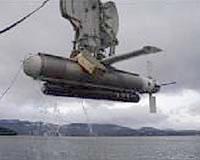 |
| Aurora Towfish. (DND photo) |
Kingston Class Sonar Kingston class vessels do not carry permanent sonar. Sonar is only available when the Towfish sonar equipment module is fitted. This is a high-frequency sidescan sonar used for minesweeping. An article dated 7 April 2007 and written by Dan Deeby of the Canadian Press offers some background information on the sidescan sonar.
"The AN/SQS-511, first delivered in 1999 had to be mothballed four years later because of chronic breakdowns. It was designed as a side-scan sonar in the 1990s to take highly detailed pictures of the deep seabed along key waterways and to watch for mines and other hostile devices. No commercial version was then available, so the navy underwrote production of four prototypes for its fleet of twelve MCDV's with MacDonald, Dettwiler and Associates Ltd. as prime contractor. The five-metre, torpedo-shaped devices were state-of-the-art, but by 2003 none could be used because a key sensor failed in all four. The failures occurred after the manufacturer's one-year warranty had expired but well before the 10-year projected lifespan of the "towfish," which got their name because they're towed behind the MCDV's.There has been a new development regarding SONAR and the Kingston class vessels which is detailed in this news release by the Canadian Navy.The AN/SQS 511 system was purchased for operational and training missions despite the fact that it was a prototype, according to one internal briefing note which was obtained under the Access to Information Act. Since its purchase, the four payloads have never been fully operational. The system has been plagued by inoperative electronics and excessive costs for repair.
Originally, the Canadian Navy ordered just two years' worth of spare parts and has since then had to cannibalize one of the prototypes to keep the other three operational. The estimated cost of buying a replacement towfish, now at about $10 million (April, 2007), is considered prohibitive. HMCS Whitehorse has twice smashed its towfish as it tried to make it work even with faulty electronics. The first incident on Oct. 14, 2005, cost $93,000 in repairs after the device crashed into an underwater pinnacle off Vancouver Island. The second crash on June 15, 2006 is expected to cost the navy up to $200,000 in repairs.
In the meantime, much cheaper commercial models have become available -- and have done yeoman's service for the navy, which bought two from L-3 Klein Associates Inc., a U.S. firm. Klein side-scan sonars have helped locate wreckage from the Swissair crash in 1998, from a Snowbird crash in Lake Erie in 2001, from a Cormorant helicopter crash off Nova Scotia in 2006, and searched for AVRO ARROW models in lake Ontario.
A navy spokesperson defended the AN/SQS 511, calling it cutting-edge technology not intended to last a long time. "Back in 1999, it was the best system in the world for its ability to find targets," Lt.-Cmdr. James Hewitt said. "
Canadian Navy Trials Active Towfish
by Canadian Navy Staff Writers
Port Coquitlam, Canada (SPX) Apr 24, 2008ISE's Aurora Active Towfish was successfully towed for the first time from existing route survey equipment belonging to the Canadian Navy aboard a Maritime Coastal Defense Vessel (MCDV) off the coast of Vancouver Island. Built in the 90's for coastal defense, the Canadian Navy's MCDVs were equipped with Route Survey System (RSS) payloads consisting of a high performance multibeam sonar built into a variable depth actively controlled towfish, and a shipboard handling system.
However, over the years, the operation of the variable depth active towfish has become problematic. As the Navy's successful Interim Remote Minehunting and Disposal System (IRMDS) currently incorporates ISE's Aurora variable depth towfish, there was an opportunity to integrate the Aurora towfish with the existing RSS handling device and demonstrate the resulting towing performance from an MCDV. The integration of Aurora with the RSS handling system was extremely straightforward, requiring minimal modifications to the towfish docking mechanism.
This towing trial is part of the Route Survey System Life Extension (RSSLE) project's definition phase. During the three days of towing, over 20 hours of towing was completed in conditions including 25 to 30 knot winds and sea states up to 4. The Aurora towfish provided very stable performance during unfamiliar handling maneuvers, launch and recovery, and operations with both faired and un-faired cabling at a variety of cable scopes, speeds, and depths.
This indicates the Aurora can meet the Navy's towing requirements for the next generation of high performance mine hunting sonars. The Aurora Towfish is owned by Defense Research and Development Canada (DRDC) Atlantic, and has been a part of a working relationship between DRDC and ISE for over 20 years. It is an integral part of the Canadian Navy's IRMDS program. ISE is extremely pleased to be a part of the RSSLE program and looks forward to future integration.
Aurora Towfish. (DND photo)
Contributors and Credits: See main page
Back to Kingston Class
Sept 16/11